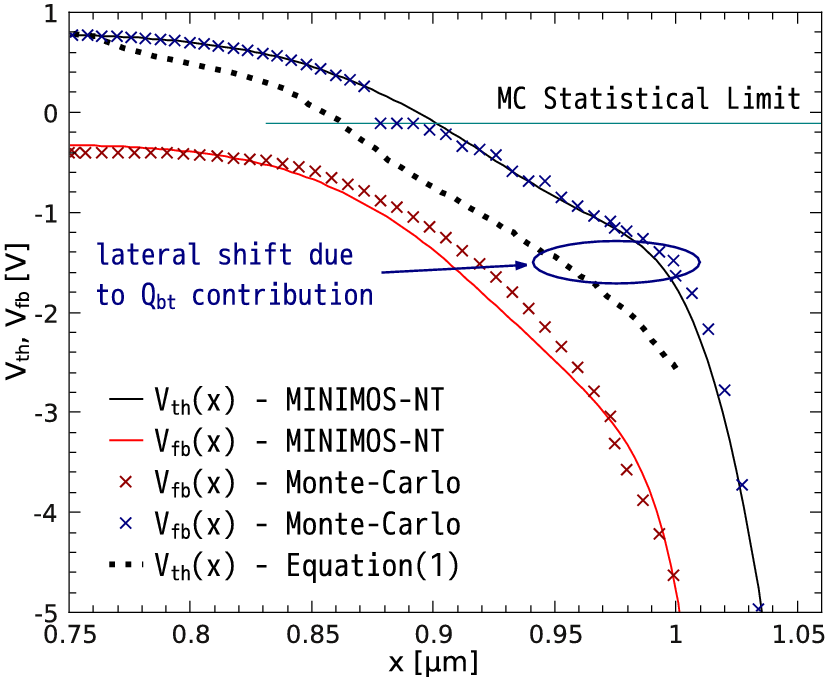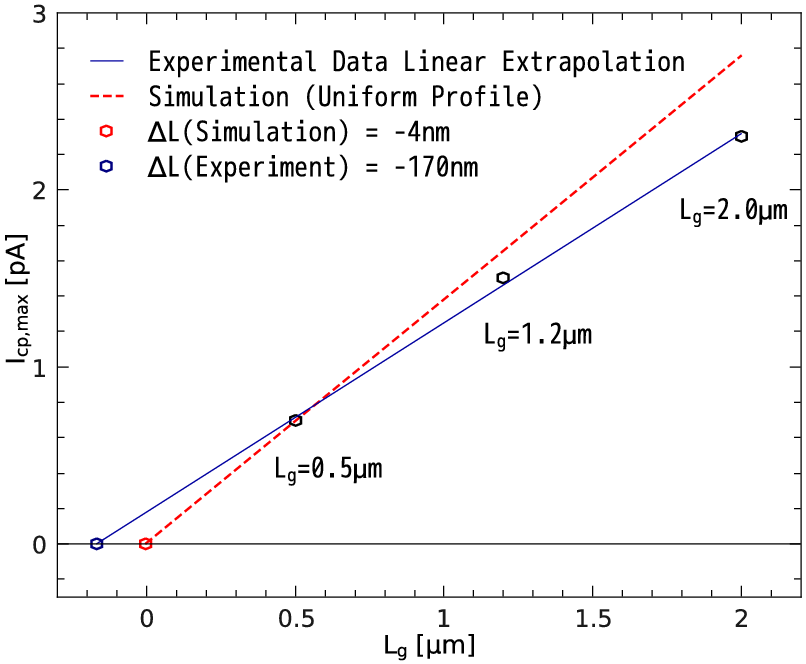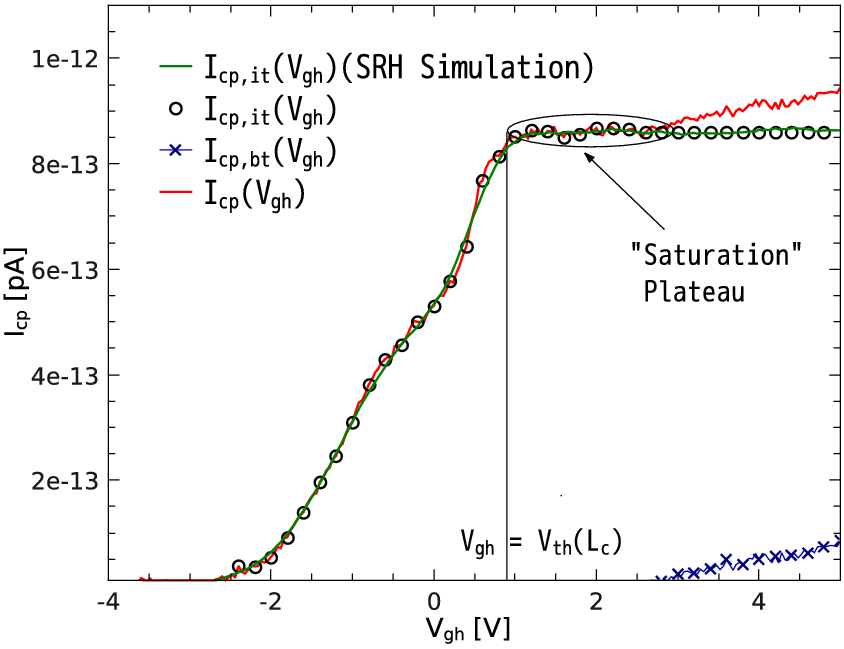Next: 4.2.2 Interface State Profile of an Unstressed Device Up: 4.2 Interface State Profile of Unstressed Device Previous: 4.2 Interface State Profile of Unstressed Device
The uniformity of the initial interface trap distribution can be verified using the dependence of the maximum value of the charge pumping current (Icp,max) versus the nominal gate electrode length (Lg). A linear relationship between Icp,max and Lg would suggest an absence of disparity between the interface state density near the source-drain region and the center of the channel. In this case the assumption that the pre-stressed Nit profiles are uniform along the channel is adequate [175]. Extrapolation to Icp,max = 0 reveals the difference (ΔL) between the nominal (Lg) and effective (Leff) channel lengths, which contributes to the CP current [173]
| (4.4) |
A limited number of works devoted to Nit(x) extraction techniques from the CP current, where this dependence has been verified, is available [175,177,164]. However, from the physical viewpoint, it is difficult to evaluate the legitimacy of the obtained findings in the last two papers. In fact, in [177] only two gate lengths are used with a limited Lg spread, while a suspiciously linear behavior is presented in [164].This suggests that this issue demands a more detailed analysis.
 |
To determine the effective length Leff, a careful calculation of local flatband Vfb(x) and threshold Vth(x) voltage distributions as crucial quantities controlling the matter is performed. Due to the symmetry of the source and drain for the fresh device, results only for the drain half of the device are presented, confirmed in [178]. For an unstressed transistor Vth(x) and Vfb(x) can be obtained with the method described in Section 4.1 employing the device simulator MiniMOS-NT. The carrier distribution required for the local threshold and flatband voltage calculation was estimated to be 2× 013cm-3 and 8×1014cm-3 for the simulation. The validity of the obtained curves has been verified using the Monte-Carlo device simulator MONJU. Figure 4.5 shows a good agreement between the results. Note that in the low voltage region the agreement degrades due to the stochastic nature of the Monte-Carlo approach which can not provide enough precision in this area. As stated in [173,175], the effective channel length for a constant base-level charge pumping technique is defined as Leff = 2|l - Lc| for Vgh ⩾ Vth(Lc), where l is the solution of the equation Vfb(l) = Vgl and Lc is the center point of the channel specified by the device geometry.
(a) (b)
(b)
|
The simulation yields an effective channel length of 0.504um while Vgl was held at -5V for the fresh device. Figure 4.6a depicts Icp,max plotted vs. Lg and a simple linear extrapolation of CP data gives Leff = 0.67um, i.e. the position is practically on the drain contact. Such an experimental value of the effective channel length is extremely dubious and supports the idea of a non-uniform Nit profile. Let us emphasize that in the case of a homogeneous Nit distribution one may obtain a Vth(x) profile directly from the charge pumping current Icp(Vgh) for the undamaged device employing the method proposed in [175,178]. According to this approach
A comparison between this "experimental" and the simulated threshold voltage profiles Vth(x) can confirm the interface state density non-uniformity and is shown in Figure 4.5. However, such a wide discrepancy in the results can not be induced by the difference in initial Nit because the Vth shift corresponds to an interface trap density of ~1012cm-2, i.e. for a heavily stressed device. This anomalous offset has a simple explanation: the method based on (4.5) does not work properly due to the border trap contribution to the CP current (see Section 1.3). As it was explained in detail in [181], a presence of trapped border charges Qbt requires special attention to distinguish between contributions to Icp induced by border (Icp,bt(Vgh)) and interface states Icp,it(Vgh))
The presence of Icp,bt(Vgh) results in a spurious determination of Icp,max and Leff and, as a consequence, to an erroneous value for the uniform Nit profile. Thus, an additional separation procedure of CP current components must be performed. This separation of Icp,bt(Vgh) from the total CP current relies on the following features of the employed charge pumping technique: at Vgh ⩾ Vth(Lc) the interface state density can not increase Icp because the active measurement area has already reached Leff. That is, Icp,it(Vth(Lc)) = const. An explicitly revealed plateau (see Figure 4.6b) corresponds to the saturation of an interface trap induced dose of the charge pumping current and the absence of the Qbt contribution. This means, for Vgh⩾ Vth(Lc) the border trap contribution to the CP signal is
| (4.7) |
This finding is supported by the interface state dynamics based on the Shockley-Read-Hall theory [182] (see Figure 4.6b). The experimental data in Figure 4.6a was processed according to the described scheme.
Unfortunately, the method suggested above is not appropriate for the varying base-level technique because a continuous increase of the active measurement area occurs, when this method is implemented. Moreover, in the case of CP measurements with a lower gate pulse frequency (a few kHz [181]) it is not possible to expose the saturation plateau and a more complicated extraction scheme of border trap contributions (as proposed in [34]) must be employed.